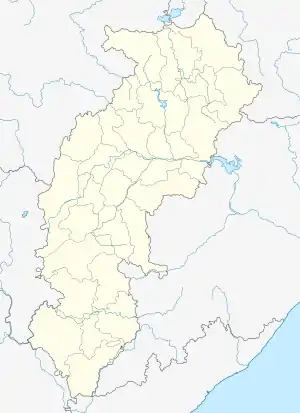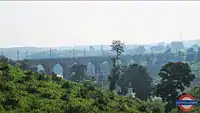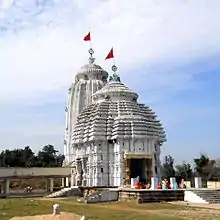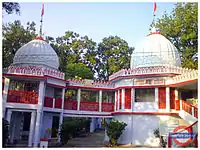Chirmiri
Chirmiri is a hill station and a Nagar Nigam in the Koriya district of the state of Chhattisgarh, India.It is famously known for its coal extraction as the area is very rich in coal.
Chirmiri | |
|---|---|
City | |
 chirmiri | |
 Chirmiri Location in Chhattisgarh, India | |
| Coordinates: 23.18°N 82.35°E | |
| Country | India |
| State | Chhattisgarh |
| District | koriya |
| Government | |
| • Body | Nagar Nigam Chirmiri |
| • Mayor | Kanchan Jaiswal (INC) |
| Population (2011) | |
| • Total | 100,800 |
| Languages | |
| • Official | |
| Time zone | UTC+5:30 (IST) |
| PIN | 497451,497449,497773 |
| Telephone code | 07771 |
| Vehicle registration | CG16 |

Geography


The city of Chirmiri is located in the geographical coordinates of 23 degrees 11 minutes and 60 seconds north latitude and 82 degrees 20 minutes and 60 seconds east longitude. The total population of the city stands at 93,366 people. The total population is segmented into 49,128 males and 44,238 females. The town has achieved a high literacy rate with 61,280 total literates in the town. The number of male literates is more than the female literates in the town. As compared to the female literate count of 24,640, the number of male literates is 36,640.
The town of Chirmiri is rich in the coal deposits found in the region. The coal industrial belt has developed in the region owing to the close proximity of the coalmines. The most reputed government undertaking and the largest coal producing industry in India, the South Eastern Coalfields Limited is located in the region. Chirmiri is one of the 13 administrative areas of the coal industry.
One of the chief tourist attractions of the region is the Lord Jagannath Temple that was designed like the temple in Puri in the state of Orissa. The town of Chirmiri is endowed with beautiful landscape that the tourists may enjoy while journeying to the town.
Climate
| Climate data for Chirmiri | |||||||||||||
|---|---|---|---|---|---|---|---|---|---|---|---|---|---|
| Month | Jan | Feb | Mar | Apr | May | Jun | Jul | Aug | Sep | Oct | Nov | Dec | Year |
| Average high °C (°F) | 23.5 (74.3) |
26.9 (80.4) |
32.0 (89.6) |
38 (100) |
42 (108) |
40 (104) |
29.7 (85.5) |
29.3 (84.7) |
29.8 (85.6) |
29.4 (84.9) |
26.5 (79.7) |
23.7 (74.7) |
30.9 (87.6) |
| Average low °C (°F) | 8.7 (47.7) |
11.4 (52.5) |
15.7 (60.3) |
20.9 (69.6) |
24.7 (76.5) |
24.8 (76.6) |
23.2 (73.8) |
22.9 (73.2) |
22.1 (71.8) |
18.1 (64.6) |
12.2 (54.0) |
8.5 (47.3) |
17.8 (64.0) |
| Average rainfall mm (inches) | 22.8 (0.90) |
22.7 (0.89) |
24.7 (0.97) |
13.4 (0.53) |
19.4 (0.76) |
212.4 (8.36) |
428.0 (16.85) |
383.2 (15.09) |
225.4 (8.87) |
55.6 (2.19) |
8.9 (0.35) |
6.3 (0.25) |
1,422.8 (56.01) |
| Average rainy days | 3.1 | 3.7 | 3.4 | 2.8 | 3.3 | 13.4 | 23.3 | 22.5 | 15.4 | 5.3 | 1.0 | 1.2 | 98.4 |
| Source: World Meteorological Organization[1] | |||||||||||||
History

At first, it was privately owned coal-mines. Dadu Lehri, as he is lovingly called, is said to be the founder of Chirimiri. Tata Iron and Steel Company then initiated prospecting of coal but no mining was carried out by them. The Chirimiri colliery was opened in 1930 (production started in 1932), New Chirimiri colliery came up in 1942, Pure Chirimiri colliery in 1945, and North Chirimiri colliery in 1946. Subsequently, New Chirimiri Pondi Hills, West Chirimiri, Duman Hill and Korea collieries started operating. Coal production rose from 264,000 tonnes in 1933 to 3,162,500 tonnes in 1980.[2]
The collieries in Chirimiri Coalfield were owned by several companies and owners such as Chirimiri Colliery Company Pvt. Ltd., Dababhoy's New Chirimiri Ponri Hill Company (Private) Limited, United Collieries Limited, K.N. Dhady and Indra Singh & Sons (Private) Limited. These were nationalized in 1973.
Economy
Chirmiri is well known for its coal mines (see Chirimiri Coalfield); mining began here in 1925. Chirmiri has a broad gauge railway link, used primarily to transport coal from the region. The coal industrial belt has developed in the region owing to the close proximity of the coalmines. The largest coal producing industry in India, the South Eastern Coalfields Limited is located in the region. Chirmiri is one of the 13 administrative areas of the coal industry.
Demographics
As of 2001 India census,[3] Chirmiri had a population of 91,312, 53% male and 46% female. Chirmiri has an average literacy rate of 66% (male 75%, female 56%), higher than the national average of 59.5%. 14% of the population is under 6 years of age.
Notable places
For the pilgrims, Chirimiri and places nearby offers temples like:

The Lord Jagannath Temple: This temple was built by the workers from Puri and is the replica of the Puri Jagannath Temple. This temple is a gift to Chirimiri by the Odia community of this region, who put their immense effort to make it a reality.

Kalibadi: The temple is in Haldibadi. It is on a hill and only 1 km. from the main station.
Baigapara: is in the place called Bartunga and also Sati temple which is a very old temple in Bartunga dedicated to Sati maa.
Gufa Mandir: Located in Godaripara
Maha Maya Temple in Ratanpur: It is one of the 52 Shakthi Peeths, in India. The temple is dedicated to the deities Goddess Lakshmi and Goddess Saraswathi. The temple was built by the Kalachuri king Ratnadeva in the 12-13th century. The architecture is of the Nagara art, facing north with a big water tank. There is a Shiva and Hanuman temple on the premises. There is a temple dedicated to Kantideval, the oldest temple, built in 1039 said to be constructed by an ascetic known as Santhosh Giri. The temple is guarded by Kalabhairava residing in another temple on the approach road. There are ruins of an 11th-century Kadaeideol Shiva temple on a hill top near a fort.
Amrit Dhara Falls are in Barbaspur. The distance from Chirimiri is about 17 km. There is a famous Shiva temple in Sidh Baba mount, near the water falls. Apart from being a famous water fall, the place is used for picnics by the locals.
Hasdeo River: The local authority has developed the banks of the river and now this is a preferred picnic spot.
References
- World Weather Information Service-Ambikapur, World Meteorological Organization. Retrieved 30 September 2012.
- Shri Kamal Sharma, Resource Development in Tribal India, p. 165, 1989, Northern Book Centre, 4221/1 Ansari Road, New Delhi, ISBN 81-85119-57-0
- "Census of India 2001: Data from the 2001 Census, including cities, villages and towns (Provisional)". Census Commission of India. Archived from the original on 16 June 2004. Retrieved 1 November 2008.